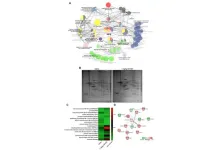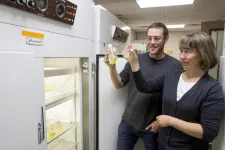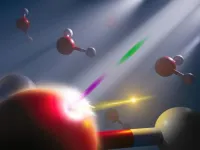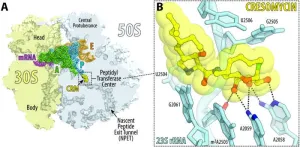(Press-News.org)
“[...] accelerated aging and Alzheimer’s disease are closely related, and this study confirmed that GV1001 has multiple anti-aging effects.”
BUFFALO, NY- February 15, 2024 – A new research paper was published on the cover of Aging (listed by MEDLINE/PubMed as "Aging (Albany NY)" and "Aging-US" by Web of Science) Volume 16, Issue 3, entitled, “GV1001 reduces neurodegeneration and prolongs lifespan in 3xTg-AD mouse model through anti-aging effects.”
GV1001, which mimics the activity of human telomerase reverse transcriptase, protects neural cells from amyloid beta (Aβ) toxicity and other stressors through extra-telomeric function, as noted in our prior in vitro studies. As per a recent phase II clinical trial, it improves cognitive function in patients with moderate to severe dementia. However, the underlying protective mechanisms remain unclear.
In this new study, researchers Hyun-Hee Park, Hyuk Sung Kwon, Kyu-Yong Lee, Ye Eun Kim, Jeong-Woo Son, Na-Young Choi, Myung-Hoon Han, Dong Woo Park, Sangjae Kim, and Seong-Ho Koh from Hanyang University Guri Hospital, Hanyang University Graduate School of Biomedical Science and Engineering and Teloid Inc. aimed to investigate the effects of GV1001 on neurodegeneration, senescence, and survival in triple transgenic Alzheimer’s disease (AD) (3xTg-AD) mice.
“ [...] we hypothesised that GV1001 might have anti-aging effects and improve neurodegeneration and senescence in vivo as a possible mechanism for its beneficial effects on AD.”
GV1001 (1 mg/kg) was subcutaneously injected into old 3xTg-AD mice thrice a week until the endpoint for sacrifice, and survival was analysed. Magnetic resonance imaging (MRI) and Prussian blue staining (PBS) were performed to evaluate entry of GV1001 entrance into the brain. Diverse molecular studies were performed to investigate the effect of GV1001 on neurodegeneration and cellular senescence in AD model mice, with a particular focus on BACE, amyloid beta1-42 (Aβ1-42), phosphorylated tau, volume of dentate gyrus, β-galactosidase positive cells, telomere length, telomerase activity, and ageing-associated proteins.
GV1001 crossed the blood-brain barrier, as confirmed by assessing the status of ferrocenecarboxylic acid-conjugated GV1001 using magnetic resonance imaging and PBS. GV1001 increased the survival of 3xTg-AD mice. It decreased BACE and Aβ1-42 levels, neurodegeneration (i.e., reduced CA1, CA3 and dentate gyrus volume, decreased levels of senescence-associated β-galactosidase positive cells, and increased telomere length and telomerase activity), and levels of ageing-associated proteins.
“We suggest that GV1001 exerts anti-ageing effects in 3xTg-AD mice by reducing neurodegeneration and senescence, which contributes to improved survival.”
Read the full study: DOI: https://doi.org/10.18632/aging.205489
Corresponding Authors: Sangjae Kim, Seong-Ho Koh - chiron@gemvax.com, ksh213@hanyang.ac.kr
Keywords: 3xTg-AD mice, GV1001, neurodegeneration, anti-aging, Alzheimer’s disease
Click here to sign up for free Altmetric alerts about this article.
About Aging:
Launched in 2009, Aging (Aging-US) publishes papers of general interest and biological significance in all fields of aging research and age-related diseases, including cancer—and now, with a special focus on COVID-19 vulnerability as an age-dependent syndrome. Topics in Aging go beyond traditional gerontology, including, but not limited to, cellular and molecular biology, human age-related diseases, pathology in model organisms, signal transduction pathways (e.g., p53, sirtuins, and PI-3K/AKT/mTOR, among others), and approaches to modulating these signaling pathways.
Please visit our website at www.Aging-US.com and connect with us:
Facebook
X, formerly Twitter
Instagram
YouTube
LinkedIn
Reddit
Pinterest
Spotify, and available wherever you listen to podcasts
Click here to subscribe to Aging publication updates.
For media inquiries, please contact media@impactjournals.com.
Aging (Aging-US) Journal Office
6666 E. Quaker Str., Suite 1B
Orchard Park, NY 14127
Phone: 1-800-922-0957, option 1
###
END
MIAMI, FL – February 15, 2024 – A study co-led by researchers at Miami Cancer Institute, part of Baptist Health South Florida, found that ablative stereotactic magnetic resonance (MR)-guided adaptive radiation therapy may improve local control (LC) and overall survival (OS) in patients with borderline resectable (BRPC) and locally advanced pancreas cancer (LAPC). Long-term outcomes from the Phase 2 SMART trial demonstrate encouraging OS and limited toxicity as published recently in Radiotherapy & Oncology (“The Green Journal”).
“Pancreatic ductal adenocarcinoma is a leading cause of cancer death. Surgery is the only known ...
One of the grand challenges for materials science is the design and discovery of new materials that address global priorities such as Net Zero.
In a paper published in the journal Science, researchers at the University of Liverpool have discovered a solid material that rapidly conducts lithium ions. Such lithium electrolytes are essential components in the rechargeable batteries that power electric vehicles and many electronic devices.
Consisting of non-toxic earth-abundant elements, the new material has high ...
Why do Serengeti zebra, wildebeest, and gazelle – all sharing limited food resources – follow the same migratory routes, one after another, in a body-size dependent way? This longstanding question has now been evaluated by researchers who used novel data to show how a balance of species interactions and ecological factors regulate this process. They say competition pushes zebra ahead of the wildebeest, and wildebeest then eat plants in a way that facilitates development of newer growth the trailing gazelle like. “Our results highlight a balance between facilitative and competitive forces,” the authors say. Large seasonal migrations are a ...
Oxygenation in the tropical North Pacific Ocean increased during a warm climatic interval that occurred roughly 56 million years ago, despite high global temperatures, according to a new study. Its findings offer insights into how modern tropical oceans may respond to ongoing anthropogenic climate warming. The availability and distribution of dissolved oxygen in Earth’s oceans play a fundamental role in supporting marine ecosystems and marine life. However, oxygen in the global oceans is declining in response to anthropogenic warming. Although these trends writ large are predicted to continue, the future of oxygen in the highly productive ...
Cresomycin – a novel synthetic molecule – demonstrates remarkably robust efficacy against multiple, evolutionary divergent forms of antimicrobial resistance (AMR), researchers report. The emergence and widespread distribution of bacteria broadly resistant to approved antibiotics raises serious global public health concerns. Given the growing rate of deaths attributable to antimicrobial resistance (AMR) worldwide, it’s evident the pace of discovery and development of antibiotics effective against AMR has not kept up with the need. Many small ...
For his work in furthering the understanding of how the human immune system senses dangerous invading pathogens, Bingxu Li has received the 2024 Michelson Philanthropies & Science Prize for Immunology. Li’s prize-winning essay investigates the role that Stimulator of Interferon Genes, or STING, plays in including multiple distinct defenses against viruses, bacteria, and tumors and in orchestrating myriad downstream responses upon activation – resolving a significant mystery in the field of innate immunity. The sensing and clearance of invading pathogens ...
Scientists have observed so-called 'roaming' chemical reactions, those that at certain points move away from the lowest minimum energy 'path of least resistance', in highly excited energy states for the first time.
Chemical reactions are supposed to occur along their minimum energy paths. In recent years, so-called roaming reactions that stray far from this path have begun to be observed, but only for chemical species in their ground state or, at most, their first excited state. However, researchers have now observed a roaming reaction even in highly excited energy states.
The researchers ...
Researchers at Michigan State University and the Carnegie Institution for Science have developed a model that connects microscopic biology to macroscopic ecology, which could deepen our understanding of nature’s laws and create new opportunities in ecosystem management.
Reporting in the journal Science on Feb. 16, the team showed how microscopic relationships in plankton — such as between an organism’s size and nutrient consumption — scales up to predictably affect food webs.
“Using data that other researchers have measured at the microscale about these organisms, our model can predict what’s happening at the scale of whole ecosystems,” said Jonas ...
RICHLAND, Wash.—In an experiment akin to stop-motion photography, scientists have isolated the energetic movement of an electron while “freezing” the motion of the much larger atom it orbits in a sample of liquid water.
The findings, reported today in the journal Science, provide a new window into the electronic structure of molecules in the liquid phase on a timescale previously unattainable with X-rays. The new technique reveals the immediate electronic response when a target is hit with an X-ray, an important step in understanding the effects of radiation exposure on objects and people.
“The chemical reactions induced by radiation ...
A new antibiotic created by Harvard researchers overcomes antimicrobial resistance mechanisms that have rendered many modern drugs ineffective and are driving a global public health crisis.
A team led by Andrew Myers, Amory Houghton Professor of Chemistry and Chemical Biology, reports in Science that their synthetic compound, cresomycin, kills many strains of drug-resistant bacteria, including Staphylococcus aureus and Pseudomonas aeruginosa.
“While we don’t yet know whether cresomycin and drugs like it are safe ...





